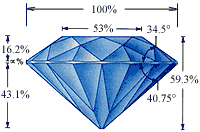The Finest Engagement Ring Brands
Choosing an engagement ring is a significant milestone in one’s life journey, and finding the perfect brand can make this experience even more memorable. Some brands stand out among the…

Marcel Tolkowsky was a Belgian engineering student from a family of diamond cutters. In 1919, while studying for his PHD, Tolkowsky wrote a thesis on the proportions for round brilliant cut diamonds that was first published in his book Diamond Design. His formula focused on the proportions that would unleash the most fire and brilliance based on the physics of light, although the concept of scintillation (sparkle) received no attention in his dissertation.
It is also interesting to note that while the Tolkowsky name is inextricably coupled with the Ideal cut diamonds due to his published academic work, a number of American cutters including Henry Morse had already been cutting to the specifications that Tolkowsky had “discovered”, for many years before his famous work was published.
As a result, Tolkowsky’s specifications have been used in connection with a wide range of diamond terminology including the American Cut and the American Ideal, as well as the Tolkowsky Cut and the Tolkowsky Brilliant. The specifications Tolkowsky published continue to be used by modern diamond cutters as a general guide for optimised round brilliant cuts.
The American Gem Society adopted Tolkowsky proportions as a basis for their Ideal Cut designation when their laboratory (AGSL) specializing in cut quality was opened in 1996. After further research, the AGSL developed a sophisticated ray tracing light performance cut grade system that further validated the main conclusions of Tolkowsky.
The term ‘round brilliant’ came to light after Tolkowsky’s cut specifications were printed. Tolkowsky stated that 25 pavilion facets and 33 crown facets must be perfectly proportioned in order to produce the best light return in a round cut diamond. He also outlined the following angles and depths:
| Crown Angle | 34.5º |
| Pavilion Angle | 40.75º |
| Total Depth | 59.3% |
| Total Diameter | 53% |
| Pavilion Depth | 43.1% |
It took 8 decades for the industry to realize that his theorem did not describe just a single proportion but a range of proportions, as first noticed by Mr. Bruce Harding who posts here on PS. Tolkowsky was also aware of a trade-off between maximum diamond brilliance and maximum diamond fire that results from varying combinations of crown and pavilion angles.
With thanks to mathematician Jasper Paulsen, you can read Tolkowsky’s entire book here and play with Jaspers mathematic modelling software online. Note that as you thicken the girdle the optimum table size increases, explaining why 57% is really the correct table size for a thin to medium girdle. Tolkowsky did all his math without a girdle – it would have been hard enough in the days before computers and calculators!
The Tolkowsky name carries significant weight within the diamond industry and some vendors have used it to their advantage. You may see diamonds that seem far from ideal with the Tolkowsky name attached to them; used as a marketing tool, some companies will create their own tolerances that sit in and around the Tolkowsky specifications and advertise these as ‘Tolkowsky Diamonds’. In many cases, these diamonds greatly deviate from Tolkowsky’s specifications with some reports that even the number of facets differs from the 58 that Tolkowsky detailed in his formula.
| EGL Tolkowsky Ideal Cut Specifications | Tolkowsky’s Original Ideal Cut Specifications | |
| Crown Angle | 33 – 36° | 34.5° |
| Pavilion Angles | 40 – 41.5° | 40.75° |
| Total Depth | 56 – 60% | 59.3% |
| Table | 53 – 57% | 53% |
The EGL will state ‘Tolkowsky Cut’ or ‘Tolkowsky Range’ on its grading reports, however, the EGL’s specifications for what constitutes an ideal cut diamond /Tolkowsky cut are quite far from Tolkowsky’s formula. It is now widely understood that there is a range of compatible proportions that make for the most beautiful round brilliant diamonds, scrutiny is needed to ensure the proportions are striking the correct balance.
Confusion also arises from Tolkowsky the brand VS the Tolkowsky name. If you see diamonds boasting a Tolkowsky Cut or Ideal cut diamonds, ask yourself who is making this claim and give close analysis to the proportions listed on the grading certificate to determine whether you are looking at an ideal cut or if it is just marketing spin. Our valued expert contributors discuss the topic of the Tolkowsky cut in this thread with some interesting results.
| Did you know… You can reject poorly proportioned diamond with PriceScope’s HCA tool or by selecting Diamond with an AGS0 report. |
Ideal Cut: Conclusion
Tolkowsky laid the groundwork for ideal cut diamonds but advances in both diamond cutting techniques and light performance analysis means that informed buyers can go beyond his original ideal cut specifications. With diamond cut playing such a crucial role in the diamond buying process, we encourage consumers to familiarize themselves with all aspects of cut quality rather than relying on a single set of proportions. Our network of diamond experts are on hand to give guidance finding an ideal cut diamond and you can read our complete guide to diamond cut for an in-depth look at this vital quality factor.
Discuss on the Forum
Crown and Pavilion »